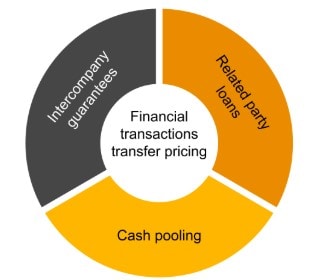By understanding and navigating evolving rules and regulations around transfer pricing in the region, organisations can ensure compliance with these rules, optimise their financial transactions and mitigate tax risks
At a glance
The concept of transfer pricing, which implies the pricing of cross-border, intra-firm transactions between related parties on an arm’s length basis, is relatively new in the Middle East. Like their counterparts worldwide, organisations in the region rely heavily on capital and financing for operations and growth. They frequently engage in significant financial transactions, such as loans and guarantees, between related parties. Tax authorities in the Middle East have recently intensified their scrutiny and enforcement of such transactions. Understanding the transfer pricing implications and compliance requirements when engaging in intercompany financial transactions is now critical for organisations operating in the region.
Countries including Saudi Arabia, the UAE, Qatar, Egypt and Jordan have recently established comprehensive legal and regulatory frameworks for pricing cross-border transactions between related entities. This report discusses the regional transfer pricing landscape, including recent learnings from interactions with tax authorities and industry best practices. It also focuses on transfer pricing considerations for related-party loans, cash pooling and guarantees, offering a regional perspective.

Global guidelines on transfer pricing regulations in the Middle East
Several Middle Eastern countries have implemented transfer pricing regulations in line with the Organisation for Economic Co-operation and Development (OECD) Transfer Pricing Guidelines for Multinational Enterprise and Tax Administrations1. These guidelines provide a globally recognised framework for ensuring that transactions between related parties occur at arm’s length – referring to the conditions and pricing that would apply if the parties were independent and unrelated.
Saudi Arabia, the UAE, Qatar, Egypt and Jordan are among the countries that follow the OECD guidelines and while Bahrain, Oman and Kuwait are yet to introduce these regulations, these countries do require arm’s length pricing under their respective tax laws.
The following considerations focus on transfer pricing for specific types of financial transactions commonly observed in the Middle East.
Related party loan transactions
Related party loans are common in multinational enterprises (MNEs) where subsidiaries borrow from parent companies or other affiliates. For all types of intragroup funding, transfer pricing rules require that the interest rates and terms of these loans align with the arm’s length principle, reflecting what independent entities would agree upon under similar circumstances.
Within the Middle East, economic instability and currency devaluations in countries such as Egypt and Lebanon may impact transfer pricing analyses for intercompany loans. This can be further complicated by lack of comparable issuances in these countries. Often a country risk premium is added to the comparable loans or central bank lending rates are used as alternatives. Another common approach to managing country risk is capping the borrower’s credit rating at the sovereign rating of its home country, reflecting its exposure to the broader economic environment. Choosing the best approach will depend on the specific facts and circumstances of the transactions under review.
A transfer pricing analysis for related party loans can be broken into three steps:
Regulatory and transfer pricing challenges of related party loans in the Middle East:
Related party loan transactions in the Middle East are subject to various regulatory frameworks and guidelines, which can vary significantly and present unique challenges. In Saudi Arabia, the Zakat, Tax and Customs Authority has reclassified related party transactions into commercial, indirect and direct financing for Zakat purposes as part of a standalone chapter on financial transactions within its transfer pricing guidelines2. Similarly, the UAE Federal Tax Authority’s corporate tax laws and transfer pricing rules require related party loans be priced at arm’s length3. Tax authorities across the region may scrutinise the economic substance of related party loans to ensure they are genuine financial transactions and not merely for tax avoidance.
Shariah-compliant financing introduces challenges due to the prohibition of conventional interest rates under Islamic law. Instead, debt-like instruments in the Middle East typically apply a profit charge or other fees. These arrangements, typically asset-backed, emphasise risk-sharing between the parties. Common Shariah-compliant instruments include Murabaha (cost-plus financing) and Musharakah (joint venture financing). Benchmarking these loans between related parties can be difficult due to the small size of the market, often requiring comparisons to third-party Shariah arrangements or adjusted conventional financing. It is critical that the transfer pricing report clearly explains the approach and avoids referring to fees as “interest” due to local sensitivities.
Cash pooling arrangements
Cash pooling arrangements allow multinational groups to centralise their cash management, optimising liquidity and reducing borrowing costs. In a cash pool, surplus funds from subsidiaries are pooled together, and deficits are funded from this central pool.
These arrangements are becoming increasingly popular in the Middle East as organisations seek to optimise their liquidity management and streamline treasury operations.
Transfer pricing challenges in cash pooling
Under the transfer pricing rules, the benefits of cash pooling need to be appropriately allocated among the participants. The OECD guidelines suggest that the cash pool leader should be compensated for its coordination role, but the majority of the benefits should be distributed to participants based on their contributions and usage.
Generally, there are two types of cash pooling arrangements:
- Physical pooling: The bank account balances of the pool members are transferred daily to a single central bank account owned by the cash pool leader.
- Notional pooling: The bank notionally aggregates the various balances of the individual accounts and pays or charges interest according to the net balance.
Members of the cash pool typically participate as part of a broader group strategy of providing liquidity. It is crucial to demonstrate the benefits of a cash pool, highlighting its value to each participant compared to their other realistic options.
As various entities in a cash pool may be resident across several jurisdictions, tax authorities often require MNEs to provide detailed information on the structure and returns of the pool leader, including the roles and compensation of both cash pool leader and members.
To determine fair remuneration for the cash pool leader and participants, organisations should perform a transfer pricing analysis that identifies and examines the economic risks under the OECD guidelines, such as liquidity risks and credit risks, associated with such arrangements.
Benchmarking of cash pools typically focuses on both the interest paid or received by participants and the return earned by the cash pool leader. The OECD guidelines and local transfer pricing regulations provide a framework for these benchmarking approaches. However, the challenges of evaluating loans in the Middle East also apply to cash pool benchmarking.
Related party guarantees
A guarantee is a legally binding commitment where the guarantor agrees to assume a debtor’s specified obligation if the debtor defaults on that obligation. In transfer pricing, guarantees are critical when an MNE acts as the guarantor for a related party. Accurate delineation of financial guarantees must consider the economic benefits provided to the borrower.
From a lender’s perspective, the benefits of a guarantee can be two-fold:
- Better terms of borrowing
- Access to a larger amount of borrowing
Borrowers typically will not pay for a guarantee if they don’t expect a benefit in return. Pricing a guarantee involves selecting the most appropriate method for determining the arm’s length guarantee fee. It should be consistent with the actual transaction as accurately delineated through a functional analysis. The OECD guidelines provide several methods for calculating this fee, including the yield approach, cost approach and valuation of the benefit to the borrower. The most common is the yield approach, which compares the price of borrowing with and without the guarantee to assess the savings achieved by the borrower. This analysis also evaluates the credit rating of both borrower and guarantor.
Transfer pricing challenges for related party guarantees in the Middle East
Related party guarantees are common in the Middle East, particularly among the region’s large number of family-owned businesses as banks often require shareholder backing when financing private, unlisted companies. However, as transfer pricing regulations are relatively new in the Middle East, these guarantees are often provided free of charge, which may pose a risk in the guarantor’s jurisdiction on the basis that there should potentially be a guarantee fee earned. Tax authorities could challenge the absence of such a fee. However, in certain limited cases, not charging a guarantee fee may be justifiable if one or more of the following apply:
- The guarantee allows the borrower to obtain funds that it would otherwise not be able to borrow without the guarantee
- It can be demonstrated that, in the absence of the guarantee, the guarantor would still intervene to support the borrower in the event of a default – for example, a shareholder acting to protect their investment in the borrower or its assets
- The guarantor’s credit rating is the same or lower than the borrower’s
In instances where a guarantee fee should be charged, the outlined pricing approach is the most common methodology used to benchmark an arm’s length guarantee fee.
Key takeaways
Transfer pricing for financial transactions in the Middle East is complex and requires special attention to both internationally accepted guidelines and common local challenges. Adhering to transfer pricing regulations in this region requires thorough analysis of intercompany financial transactions. At a minimum, maintaining robust documentation and fostering proactive communication with tax authorities are vital steps in managing risks, ensuring transparency and effectively addressing the challenges of related party financial transactions across jurisdictions. More information about transfer pricing considerations and recent developments in the Middle East region can be found here.
Given the complexity of these arrangements, MNEs may also want to consider entering an Advance Pricing Agreement (APA) with local tax authorities in the Middel East where possible, such as in Egypt and Saudi Arabia, to achieve tax certainty on these transactions. More information about recent updates to the APA programme in Saudi Arabia can be found here.
Focusing on these steps can help MNEs navigate the challenges of related-party financial transactions across jurisdictions more effectively, enabling compliance and minimising potential disputes.
Let’s talk
For a deeper discussion on financial transaction transfer pricing and how your organisation might be affected by local regulations, please contact the financial transaction transfer pricing team at PwC Middle East:








